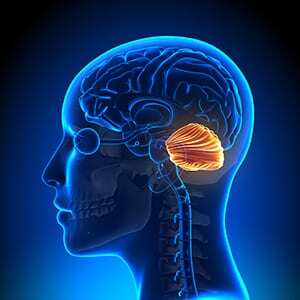Fun Facts Friday
Welcome to Dr. Ginny’s Fun Facts Friday where we will take a brief look at one area of the vast and interesting world of psychology, brain anatomy and neuroscience, and discuss how it relates to our own lives.
Today, we will be looking at a small, but an essential structure that lies at the back of our brain called the cerebellum, which means the little brain in Latin.
In the picture to the right, you can see where the cerebellum is located towards  the bottom back of the brain.
the bottom back of the brain.
An interesting fact about this region of the brain is that it actually holds 50 percent of the brain’s neurons.
This part of the brain is important because it acts as our coordinator, helping us with balance, motor control, and directed movement. This is the part of the brain that allows us to be able to throw a ball, utilize fine motor skills, or even walk across the street.
Through neuroimaging, we now understand that this region of the brain is also active during cognitive tasks such as when we are involved with mental imagery, attention, and language. The cerebellum is tightly interconnected with the brain’s prefrontal association areas, regions of the brain responsible for abstract thinking, planning, and constructing meaningful perceptual experiences.
In 2015, researchers at Stanford University were able to look into possible ways that the cerebellum is involved in our ability to be creative. Their findings showed that there is evidence that the cerebellum is involved when we are processing ideas. These researchers proposed that one possible way the cerebellum does this is by arranging our thoughts together, matching them up, and creating new correlations.
When there is damage to the cerebellum
Problems in this part of the brain are rare, but when there are problems associated with the cerebellum, a wide range of symptoms can emerge. Some of the common symptoms that can occur when there is damage to the cerebellum include:
-
Difficulty in carrying out rapid or alternating movements
-
Intention tremors
-
Wide based and staggering gait (Acute cerebellar ataxia)
-
Scanning speech which occurs when spoken words are broken up into separate syllables, often separated by a noticeable pause and spoken with varying force.
-
Lack of muscle control and coordination
-
Nystagmus which is a vision condition in which the eyes make repetitive, uncontrolled movements.
How does damage occur?
Some physical circumstances can cause direct damage to the cerebellum. For example, accidents and physical trauma to the back of the head. Hemorrhagic stroke (which occur when a person with high blood pressure has a blood vessel burst) or Ischemic stroke ( when a clot in the heart or large arteries break off) can also cause damage.
A primary physician can do a specific diagnostic exam to assess an individual with potential damage to the cerebellum and determine the level of impairment. The good news is that in some cases, damage to a portion of the cerebellum can be offset by another portion that is not damaged.
Do your part and protect your brain
One thing that I admonish everyone I can is to always protect your head and  think head safety first.
think head safety first.
We can begin to protect our brain by first living a healthy lifestyle that reduces the risk of strokes, brain injury, and exposure to poisons and toxins.
Always wear a helmet when participating in activities (such as riding a bike, scooter, skateboard, and high impact sports) that could cause potential damage to our heads. Eat healthy foods, exercise, and get plenty of sleep regularly.
These small but essential suggestions can make a big difference in our overall brain health and our enjoyment of life.
